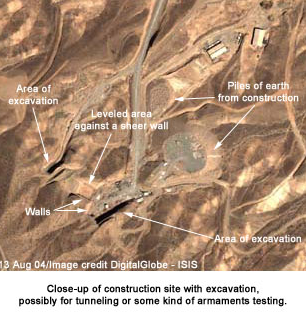
institute for science and international security
Parchin is the Iranian nuclear site the the Tehran government barred IAEA inspectors from seeing this week. What could be there? There has been a cat-and-mouse game underway involving Parchin for several years, and the end game may be looming.
If this is the beginning of the end game, it has been a long time coming. “This huge complex is dedicated to research, development, and production of ammunition, rockets, and high explosives,” the independent, Washington-based Institute for Science and International Security said seven years ago. “The site, owned by Iran’s military industry, has hundreds of buildings and test sites.” Last November, the International Atomic Energy Agency spelled out why it was so interested in Parchin, some 30 kilometers southeast of Tehran:
Other information which the Agency has been provided by Member States indicates that Iran constructed a large explosives containment vessel in which to conduct hydrodynamic experiments. The explosives vessel, or chamber, is said to have been put in place at Parchin in 2000. A building was constructed at that time around a large cylindrical object at a location at the Parchin military complex. A large earth berm was subsequently constructed between the building containing the cylinder and a neighbouring building, indicating the probable use of high explosives in the chamber. The Agency has obtained commercial satellite images that are consistent with this information…the Agency has been able to confirm the date of construction of the cylinder and some of its design features (such as its dimensions), and that it was designed to contain the detonation of up to 70 kilograms of high explosives, which would be suitable for carrying out the type of experiments described in paragraph 43 above.
As a result of information the Agency obtained from a Member State in the early 2000s alleging that Iran was conducting high explosive testing, possibly in association with nuclear materials, at the Parchin military complex, the Agency was permitted by Iran to visit the site twice in 2005. From satellite imagery available at that time, the Agency identified a number of areas of interest, none of which, however, included the location now believed to contain the building which houses the explosives chamber mentioned above; consequently, the Agency’s visits did not uncover anything of relevance.
Hydrodynamic experiments such as those described above, which involve high explosives in conjunction with nuclear material or nuclear material surrogates, are strong indicators of possible weapon development. In addition, the use of surrogate material, and/or confinement provided by a chamber of the type indicated above, could be used to prevent contamination of the site with nuclear material. It remains for Iran to explain the rationale behind these activities.
Over the past two days, Iran refused to let IAEA inspectors visit the site to determine for themselves what kind of work the Iranians are doing there.


